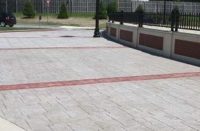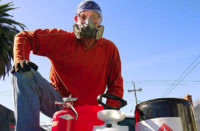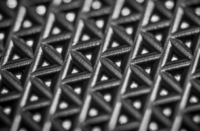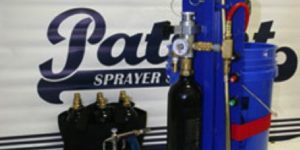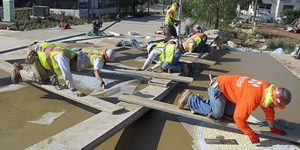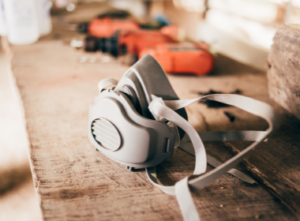There is not a comforting way to say the word “cancer.” Even in this day of strong chances of recovery and survival, it is a word that gets our attention every time. I realize this isn’t my usual, upbeat article, but the fact is, what we are working with may be killing us. Although the products we use turn normal concrete into extraordinary works of art, some of those products are carcinogenic. Many products become airborne (as particulate) and these silicas have been proven to cause the Big C. This may not worry you, but before you turn the page let me ask this: What about your children? Some doctors say the effects of what we inhale may appear in our offspring. Not a very pleasant thought, is it?
A friend told me of a conversation he had while in the waiting room for his radiation treatment. Sitting next to him was a younger man, and a conversation started between them, not unlike nervous chatter sometimes heard on airplanes. Both men compared war wounds, and the conversation quickly cut to the chase and straight to the future of each man.
Our guy told of hope and looked forward to getting his treatment behind him and his life back to normal. The rebuttal was not so bright. His new friend told a story less encouraging and felt his future was limited, to say the least. He seemed to accept the inevitable, yet found peace, all while attempting a long shot with this treatment.
As the two men tried to explain the whys and hows of their disease, the new friend explained that his doctor had no doubt the “how” was most likely connected to his line of work. For years the man had worked in a business that bagged cement in preparation for distribution. Many days were busy, and respirator masks were discarded or forgotten. Years of breathing in microscopic cement particles seemed to be the most likely cause of his disease. A young nonsmoker with terminal lung cancer is not normal. My goal is to keep this from happening to you and your crew.
I’m not going to waste space in this fine magazine with standard safety features like Band-aids and eye flushes. Every business knows by now that this is mandatory. My concern is more about the life-threatening or life-changing situations all decorative installers face daily. Part of the problem is that our society bombards us with ridiculous warning labels to which most pay no attention. You probably see them as a means to curtail frivolous lawsuits and you are right. The other day I saw a warning on an advertisement for a toilet seat, maybe designed for hunting or camping, that attaches to the receiver-style hitch of a vehicle. It warned us not to use the seat while the vehicle is moving down the road. I guess common sense should never be assumed.
Some might ask why folks in the decorative trenches who expose themselves to these dangers continue to do so unprotected. The answer is simple, considering the fact that we all need to earn a paycheck to support our families. Many in our workforce are, let’s say, discreet, and will not complain or draw attention to themselves. It is our responsibility to protect them as much as ourselves. Many workers simply don’t know the danger because it is not evident at the day’s end. Most, but not all, of these dangers are not traumas that bleed or break. The effects are slow and usually affect us later in life, although not always.
Let’s look at a few of the dangers and what we can do to protect our crews.
Airborne damage
What do you think of when you hear “airborne”? Is it dust and powder? The lungs are an amazing part of our bodies. They inhale and exhale air that provides oxygen to our bloodstream. Without this fresh oxygen, our time is limited — we all know this. I will not claim to know why and how these silica dust particles damage our lungs, but they do. It appears that our lungs cannot filter these small particles, and eventually the lungs’ capacity and health are jeopardized. The danger can come from tasks as simple as dumping bags into a mixer or broadcasting color hardener onto fresh concrete. Most release agents are light and drift in the air forever, it seems. It also appears that the lungs are not the only areas of our bodies subject to harm. Fumes from many sealers, epoxies, urethanes, release agents and solvents are extremely dangerous for a number of reasons. Everyone has heard about the effects of overdrinking daily and how this affects the liver. I bet you didn’t realize the liver also filters, in some capacity, not only things we eat and drink but also things we breathe.
These strong toxic fumes create grave concerns for a number of reasons. All of these harsh-smelling protective coatings are wrecking our unprotected bodies.
Airborne protection
I will be honest: I thought the days of using little white dust masks for complete protection were over. I was wrong. While researching for this article I learned not even my crew was completely protected. I was quite shocked at how easy it is to protect ourselves. It really boils down to two mask types in most cases. The first is an inexpensive disposable paper-style mask that costs about $1.50. This mask, when used properly, will leave particulates on your job and not in the lungs. This is the mask type to use when throwing colors or mixing powders. Your crew will simply toss them away at day’s end.
The other mask type is for the detail and seal guys that are rolling or spraying sealers, especially indoors. This mask is completely different from the particulate type, but the result is the same. Big improvements have been made in the filter area of these masks. These protective filters eliminate toxic fumes from entering your lungs and bloodstream. Be sure to ask your supplier about layers of protection before investing in a high-dollar system. This respirator system can cost anywhere from $50 to $900 depending on how elaborate you decide to go. I interviewed the owner of Guardian Safety & Supply and he had several mask options that fit well with our line of work. They also ship worldwide and seem competitive in pricing.
That was the easy part. Now comes the hard part. Getting your crew to commit to wearing them is the hardest part, I have found. This will require some groundwork, and you will need to stick to your guns, I can assure you. Your crew must understand that you spent hard-earned money on their behalf and these masks must be worn when necessary. A few surprise visits to your site will help ensure their use. Letting a guy sit at home for a day or two will show the seriousness of usage too. Many workers will misplace or lose the masks, so I recommend making one person in charge of them. This will keep you from constantly replacing costly masks. The bottom line is they must be sold on the fact that this is for THEIR protection.
For more on masks, Doug Carlton recommends visiting:
3M
(800) 247-3941
www.3m.com
A good mask for particulates is 3M brand 9211.
Guardian Safety & Supply
(888) 595-9800
www.guardiansafety.com
